Overview
- Features: Rajasthani folk dance show
- Opening Times: Bagore-ki-Haveli 10:00 am to 5:00 pm; Dharohar Dance 7:00 pm to 8:00 pm
- Best Time to Visit: Late October to early March
- Duration: 1 hour
- Travelled By: Foot
- Cost: Bagore-ki-Haveli Rs 30; Dharohar Dance Rs 100, camera Rs 50
- Address: Gangaur Ghat, Udaipur, Rajasthan, India
- Type: Event
Author Reviews[display_rating_item_results rating_form_id=”2″ rating_entry_ids=”1″ show_category_filter=”false” show_options=”true” result_type=”star_rating” preserve_max_rating=”true” show_title=”false” show_count=”false” ]
Total Rating: [display_rating_result rating_form_id=”2″ show_count=”false” show_rich_snippets=true] [accordions load=”1″] [accordion title=”User Reviews” last] [display_rating_item_results rating_form_id=”5″ show_options=”true” result_type=”star_rating” preserve_max_rating=”true” show_title=”false” show_count=”true” show_rich_snippets=true] [/accordion] [accordion title=”Add Review”][display_rating_form show_email_input=”true” show_comment_textarea=”true” show_name_input=”true” rating_form_id=”5″] [/accordion] [/accordions]
Summary
Bagore-ki-Haveli is a gorgeous 18th century haveli that has been converted into a museum showcasing Mewar art and architecture. In the evenings, the haveli puts on one of the best Rajasthani folk dance shows in Rajasthan – Dharohar Dance. For an hour, performers dance to Rajasthani folk music wearing bright coloured ethnic dresses. The dances are varied and demonstrate the tradition and culture of Rajasthani folklore.
Bagore-ki-Haveli Udaipur: Dharohar Dance Show
Bagore-ki-Haveli
Bagore-ki-Haveli is a gracious, slightly eccentric 18th-century haveli, set right on the waterfront of Lake Pichola at Gangori Ghat. It was built by Amir Chand Badwa, the Prime Minister of Mewar as a miniature of the City Palace, and has been carefully restored and converted since then into a museum with artefacts collected over the years.
The haveli has 138 rooms, as well as numerous corridors and balconies, courtyards and terraces. The rooms are set around numerous courtyards, some arranged to evoke the period during which the house was inhabited, and others housing cultural displays, including the world’s biggest turban. The cool shady courtyards contain two peacock mosaics made from small pieces of coloured glasses, as well as fretwork and carved pillars made from granite, marble and the local blueish-grey stone.
The haveli also houses an interesting art gallery, featuring fine examples of Mewar contemporary and folk art, and an eclectic selection of world-famous monuments lovingly carved out of polystyrene.
[singlepic id=2502 w=720 h=560 float=center]
The interiors of the haveli are also embellished with intricate and fine mirror work. While strolling in the Haveli, you can also see the private quarters of the royal ladies, their bath rooms, dressing rooms, bed rooms, living rooms, worship rooms and recreation rooms.
The Chambers of the Royal Ladies still bear fine frescoes of the Mewari style. There are beautiful coloured-glass windows in some of the rooms as well as two peacock coloured glass mosaics that display the superb craftsmanship of the 18th century.
Unique symbols of the Rajput clan, such as jewellery boxes, dice-games, hukkas, pan boxes, nut crackers, hand fans, rose water sprinklers, copper vessels and other items are also on display in the haveli.
A slightly forlorn but funny puppet show plays several times a day on the ground floor.
Dharohar Dance Show
[singlepic id=2511 w=720 h=560 float=center]
In the evening, the beautiful Bagore-ki-Haveli gets transformed into a colourful stage for the performance of traditional Rajasthani folk dance and music. The haveli comes to life with multi-coloured lights in the evening and hosts one of the best shows in Rajasthan.
If you want to witness Rajasthani folk dancing, this is the best place and the most convenient opportunity to watch a show. The Dharohar dance is a nightly show of colourful, energetic Mewari, Bhil and western Rajasthani dances, performed by talented Rajasthani dancers and musicians. It takes place in a courtyard called Neem Chowk (a neem tree stands in the middle of the courtyard, hence its name).
[singlepic id=2501 w=720 h=560 float=center]
The Dharohar dance show at Bagori-ki-Haveli is wonderfully organised and structured. The evening started off with a brief welcome and introduction to the show by a Rajasthani woman dressed in a beautiful sari worn in the traditional Rajasthani manner. She hosted the evening really well, and before each dance would tell us the name of the dance as well as the significance of the dance in Rajasthani folk culture.
[singlepic id=2504 w=720 h=560 float=center]
Before the start of any performance show in India, it is considered auspicious to give thanks and praise to the Hindu gods with the beating of a drum, blowing of a corn shell and a religious song.
The rest of the evening consisted of well-choreographed dances which were supported by musicians on the tabla (Indian drum) and harmonium (Indian piano).
The costumes worn by the women were beautiful examples of Rajasthani folk costumes carried down through the ages. Bright, multi coloured ghagra cholis with glass work and embroidery were displayed in their entire beauty as the women danced around the stage.
[singlepic id=2519 w=720 h=560 float=center]
First up was the Chari Dance where the performers danced with flaming brass pots on their heads. The skill of balancing the pots on their heads while they twirled around was impressive.
[singlepic id=2507 w=720 h=560 float=center]
Next up was the Terha Taal Dance where the performers played 13 different manjiras (bells) tied to their hands and legs. The coordination skill was unique here as the women had to move their legs to the rhythm of the music while sitting down.
At one point they also had to hold a knife in their mouth and a set of brass pots on their head while playing the manjiras on their hands and legs. Quite a skill indeed!
[singlepic id=2508 w=720 h=560 float=center]
[singlepic id=2500 w=720 h=560 float=center]
Following this was the Gorbandh Dance where the performers wore ornaments that are used to adorn the camels and dance in complete abandon. This was quite fun to watch as the women twirled around at very fast speeds while holding hands. It reminded me of something we used to do as children in the playground.
[singlepic id=2506 w=720 h=560 float=center]
To break the monotony of the dances, the Dharohar dance show was interrupted by a traditional Rajasthani Puppet show. This part of the show was aimed at the kids in the audience with comical skits filled with fun and laughter.
A young boy was asked to walk on to the stage and pull a string out of the puppet; the string had no end. How long is a piece of string you ask?!?
[singlepic id=2499 w=720 h=560 float=center]
The next dance was the Ghumar Dance, a high-class dance where the performers dance in rhythmic circles to the accompanying music.
[singlepic id=2518 w=720 h=560 float=center]
The final dance of the evening was the Bhavai Dance which was, in our opinion, the most interesting and challenging dance of the evening. The performer had to dance with earthen pots on her head.
She started the dance with two pots on her head while she performed various tricks such as lifting a piece of cloth off an object on the floor. As the dance progressed, there were more pots stacked on top of her head until there were 13 pots being balanced on her head. At one point, she even stood on broken glass while balancing the pots on her head which was an incredible and impressive feat.
[singlepic id=2516 w=720 h=560 float=center]
Following the dance show, the haveli open up a shop where you can buy traditional Rajasthani puppets which are a big part of the tradition and culture of Rajasthan. The funds from the sale of these puppets go toward protecting the heritage of Rajasthani folk dance and maintain the Dharohar dance school.
The Dharohar dance show at the Bagore-ki-Haveli is a colourful and wonderful dance show steeped in tradition and culture which showcases the skills and artistry of the performers. Given the crowds of Indian and foreign tourists at the show it is definitely the most popular show in town. We loved it; it was one of the best cultural performances we had been to while travelling around India for ten weeks.
Try to get to Bagori-ki-Haveli at least 30 minutes early for good seats. Seating is arranged on the floor around the stage. The floor is set up with large mattresses however it can get a little uncomfortable after a while so keep enough room around you to move your legs around during the show.



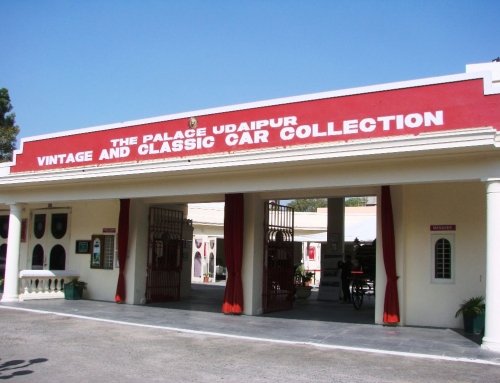
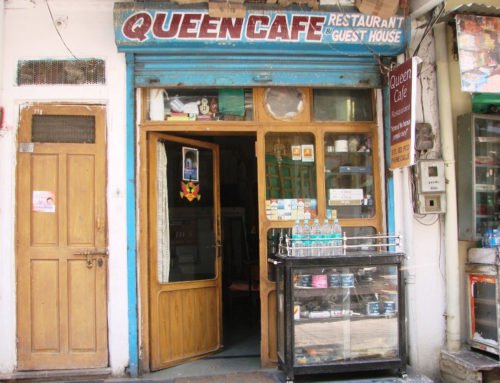
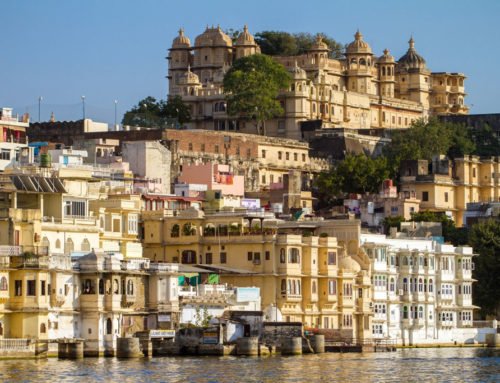
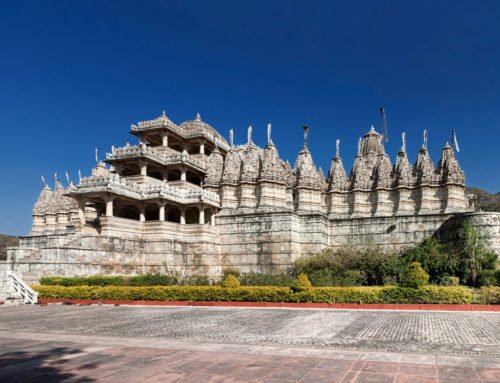
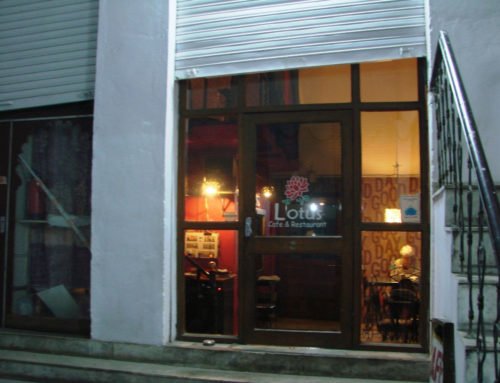
Hi there, can i buy tickets to the show in advance?
Hi Jesse, yes you can buy tickets to the show during the day, however, you can also buy them before the show begins. Just get there early for good seats.